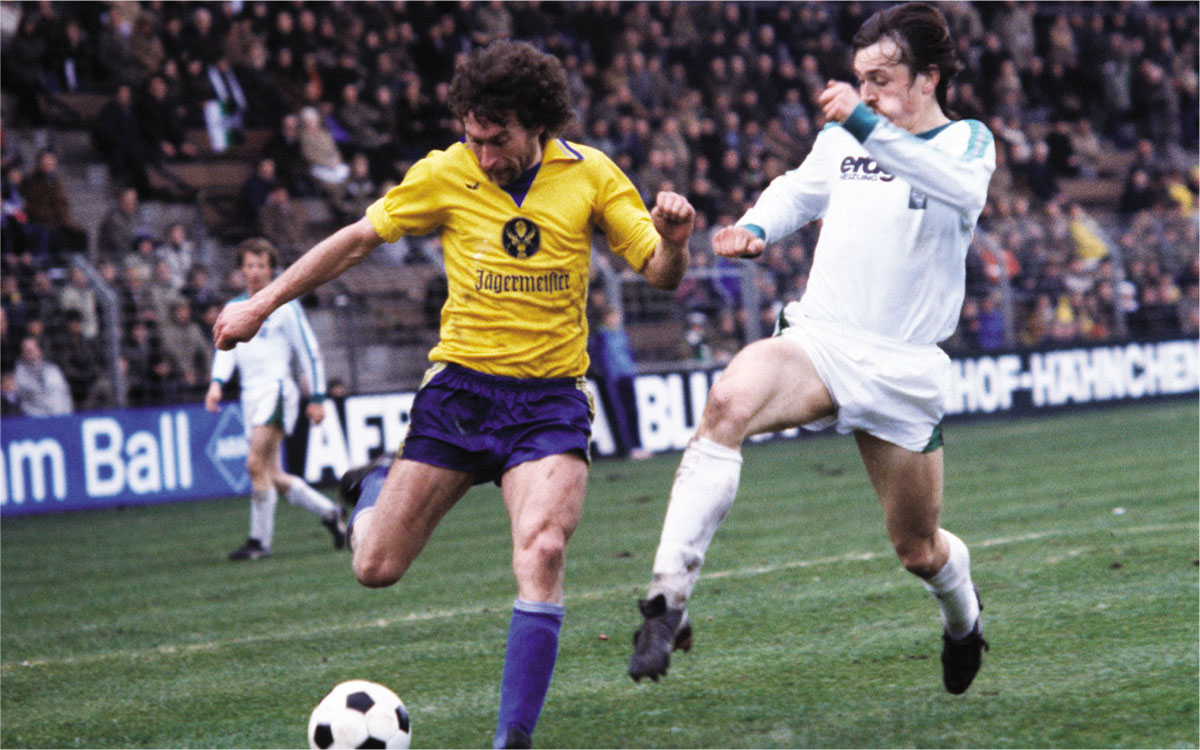
EINTRACHT BRAUNSCHWEIG
THE ALCOHOL GIANT’S ADVERTISERS
Eintracht Braunschweig revolutionised German football in 1973 as the first club to display a sponsor on their shirts. Although it was allowed in France, Denmark and Austria, it was forbidden in the rest of the footballing world. At least until Eintracht Braunschweig cheated the system.
In 1972, five years after the club’s surprising league victory, Eintracht were suffering financially because of the previous year’s bribery scandal in the Bundesliga. The club needed help and started a collaboration with the alcohol giant Jägermeister: in exchange for sponsorship money, the Braunschweig players would display the company logo. In August 1972, this project was given the thumbs down by the German Football Association, which made Jägermeister’s owner Günter Mast and Eintracht’s chairman Ernst Fricke think again. Advertising on the kit may have been forbidden, but perhaps they could do something with the club crest?
In January 1973, members of the club voted through a proposal that meant that the club’s red lion was exchanged for the stag’s head of Jägermeister. Furthermore the emblem was given a central position on match shirts. The German Football Association was bewildered – and could do nothing because there were no rules concerning club crests. The only thing they could oppose was the size of the crest, which was not allowed to be bigger than 14 cm (5½ inches), so the referee Franz Wengenmayer measured Braunschweig’s emblem when it was first used, on 24 March, 1973,. When the match kicked off, so began a new era in the history of fooball. Seven months later, approval was given for sponsors’ names and logos to appear on match kits in Germany, and clubs including Hamburg, Eintracht Frankfurt, Fortuna Düsseldorf and Duisburg joined Braunschweig. UEFA took another nine years before approving sponsorship on shirts.
CLUB: Braunschweiger Turn- und Sportverein Eintracht von 1895
NICKNAME: Die Löwen (the Lions)
FOUNDED: 1895
STADIUM: Eintracht-Stadion, Braunschweig (23,325 capacity)
HISTORIC PLAYERS: Werner Thamm, Franz Merkhoffer and Paul Breitner

1906–1920. Between 1895 and 1906, the club was represented solely by the city of Braunschweig’s red lion, a symbol that harked back to the 14th century and which features in the city crest. In 1906 it was framed by the name of the club with the additional colours blue and yellow. These colours have a historic link to the region, coming from the flag of the province of Braunschweig.

1973–1987. For nearly 50 years the club used four different emblems portraying the lion. But after the advertising coup with Jägermeister, a crest with the company’s stag and its adjoining cross, flanked by the club’s initials, started to be used. The only element remaining from earlier crests was the blue circle and the name of the club. In 1983 the brewing magnate Günter Mast took over the role of chairman and immediately proposed that the club be renamed Jägermeister Braunschweig. Although the members backed the proposal, it was stopped by the German Football Association, leading to the departure of Günter Mast from both club and football in 1985.

1987–2012. With Jägermeister out of the picture, Eintracht Braunschweig returned to its roots and reintroduced the lion into its crest. The early colours were also brought back, but in place of the circle the heraldic animal was now framed by a square. This particular form was much criticised by fans.

2012–present. At the end of 2011, the members of Eintracht Braunschweig voted through a change of their crest. Therefore, in March 2012, and much to the joy of many of their supporters, the classic emblem returned albeit with a modern twist.

2016/2017. To celebrate the 50th anniversary of the club’s only league title, the Braunschweig players wore this badge for the 2016/2017 season.

With the Jägermeister brand embedded in the club badge, Eintracht Braunschweig were trailblazers in terms of using the club crest as a means to generate commercial revenue.